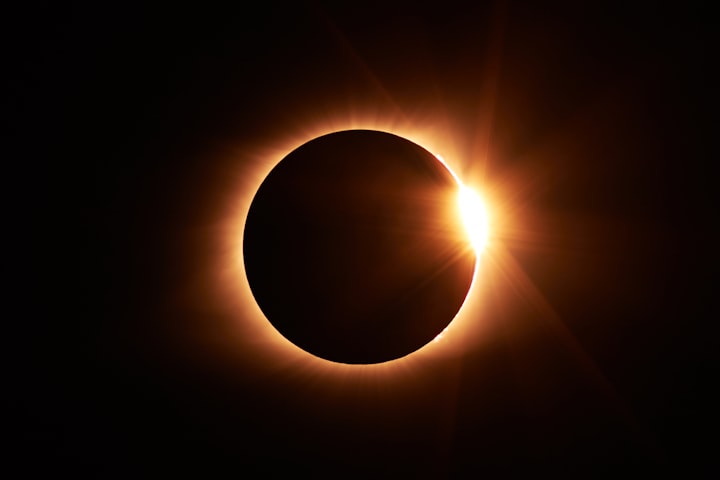
October's sky is loaded with fantasies and legends as well as splendid planets and other enormous joys. The fresh nights offer clear skies and cool temperatures for stargazers. Features incorporate the "ring of fire" sun powered obscure on Oct. 14 and the tracker's moon fourteen days after the fact.
Need to know how your activities can assist with significantly impacting our planet? Pursue the Environment Mentor pamphlet, in your inbox each Tuesday and Thursday.
A 'ring of fire' sun oriented overshadow
On Oct. 14, the moon will pass before the sun, clouding quite a bit of it yet abandoning a splendid ring, or annulus, of unfiltered daylight. This is known as an "annular" or "ring of fire" sun based obscure.
Watchers along a track reaching out from Oregon through the Four Corners district toward the south Texas coast will see the moon bit by bit cover the sun until the dim lunar circle is encircled by the searing ring.
Albeit just those along the overshadowing's centerline will see the ring of fire, all inhabitants of the Lower 48 states will actually want to see basically a fractional sun powered obscure. The nearer you are to the centerline; a greater amount of the sun's circle will be clouded by the moon.
In Washington, the fractional overshadowing starts around early afternoon on the fourteenth, with most extreme obscuration happening at 1:19 p.m. Eastern. Right now, around 30% of the sun's circle will be darkened by the moon. The obscuration closes at 2:39 p.m.
Since the sun isn't totally impeded in this overshadowing, it requires the utilization of particular eye assurance to stay away from extremely durable harm while watching it.
To see the full exhibition of sun based overshadow in which the moon totally conceals the sun and uncovers the unobtrusive sparkle of the sun's environment or crown, you need to hold on until just spring. On April 8, 2024, the following "Extraordinary American Overshadowing" will cross the focal and northeastern US.
Ride with the tracker's moon
The moon starts the month ascending in the late night close to Jupiter. During October's most memorable week, you will track down our normal satellite going through the brilliant stars of the colder time of year heavenly bodies prior to moving into the rising stars of the springtime sky.
The moon is missing from the sky at mid-month when the sunlight based obscure happens. Be that as it may, it gets back to wax to its full stage, which falls on the 28th at 4:24 p.m. Eastern time. Go-getters on the morning of the fifth can recognize the moon near the brilliant star Pollux, while the moon gives stunning Venus a visit in the pre-sunrise sky on the tenth. The moon visits Saturn on the night of the 23rd and rejoins Jupiter on the 28th.
October's full moon on the 28th is commonly known as the tracker's moon, and it shares a portion of the very orbital math that created last month's reap moon. Yet again the shallow point of the moon's circle concerning the eastern skyline causes progressive moonrises to be around a similar time. Since the fields have proactively been collected, there is little cover for game birds and creatures, and trackers exploit the illumination of the rising moon to seek after their quarry.
Stories in the stars
The harvest time sky makes a fascinating gathering of groups of stars visible that are characters in one of the extraordinary legends of old Greek folklore. You will find these heavenly bodies high in the northeastern sky at around 10 p.m. in mid-October.
Begin your inquiry by finding a conservative gathering of stars that look like the letter W. These stars’ address Cassiopeia, the legendary sovereign of Ethiopia who was consumed by her vanity. She invested a lot of her energy looking at herself in a mirror and flaunted that her magnificence outperformed those of the Ocean Fairies, the mythical being little girls of Neptune. Normally, this brag by a simple human raised a ruckus, Neptune requested proper compensation as a penance. The person in question, however, would be Cassiopeia's little girl Andromeda, who was tied to a stone to be gobbled up by the ocean beast Cetus.
All seemed lost until the appearance of the legend, Perseus, on his flying horse, Pegasus. Perseus had recently dispatched the brutal Gorgon Medusa, who had snakes for hair and could go individuals to stone with her look. Perseus decapitated Medusa by checking out at her appearance in his cleaned safeguard. After finding the bound Andromeda, Perseus prepared the cut off Medusa's head toward Cetus, who in a flash transformed into a monster rock. Andromeda and Perseus rode Pegasus off to a blissful closure, and Cassiopeia took in a significant opportunity to learn something new.
The stars of Cassiopeia stand over a wishbone-molded asterism that addresses Perseus. In the event that you observe intently more than a couple of evenings, you might see that the second-most splendid star in Perseus seems dimmer each 2.86 days. Known as Algol, it addresses the stink eye of Medusa, actually winking at us throughout the long term.
High in the southeast you will find a huge square-formed heavenly body that addresses Pegasus, and among Pegasus and Perseus you will view as two "chains" of stars that begin from the star in the upper left corner of the square. These are the chains that bound Andromeda to her close to destiny.
Concerning Cetus, he involves a fairly star-unfortunate district low on the southeast skyline, however he has a partner on The planet. The stone that he became is the renowned Stone of Gibraltar.
Saturn and Jupiter light up the night as Venus welcomes go-getters
Saturn shows up in the southeastern sky as nightfall blurs and is handily seen throughout the month. The planet is a most loved focus of anybody with a telescope, and survey it unavoidably causes a feeling of skepticism. (Geoff Chester)
Saturn shows up in the southeastern sky as sundown blurs and is effortlessly seen throughout the month. The ringed planet possesses a district of extremely faint stars, and its yellow gleam stands apart among the weak heavenly bodies. Saturn is a most loved focus of anybody with a telescope, and review it definitely causes a feeling of skepticism. The rings are genuine, notwithstanding, but transient on the grandiose scale. In two or three million years, they will never again exist.
Jupiter rises logically prior every evening, and by mid-month it overwhelms the eastern late night sky. It is maybe the most compensating planet for little telescope proprietors in light of four splendid moons change their situations from one night to another. The planet's circle is adequately enormous to show its dull tropical cloud belts, and at times one could locate the Incomparable Red Spot, an Earth-sized storm in Jupiter's climate that has endured for about 300 years.
The planet march closes at day break, when Venus astonishes ambitious people with its serious white gleam. It will elegance the morning sky until the start of the following year.






Comments (1)
Great work! Wonderful!